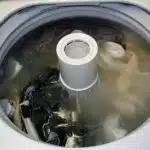As a laundry detergent expert, I am often asked the question “how much laundry detergent should I use?” It’s an important question, as using too much or too little can affect the cleanliness and quality of your clothes. In this article, we will explore the factors that determine how much laundry detergent to use and provide some guidelines for finding the right amount for your washing needs.
Firstly, it is important to understand that the amount of detergent needed depends on several factors such as the size of your load, water hardness, soil level, and type of fabric. Using too little detergent may result in clothes not being clean enough while using too much can leave residue on clothing or even cause damage to the fabric over time. Therefore, finding the correct amount is crucial for both cleaning effectiveness and garment longevity. In this article, we will break down each factor and provide tips on how to adjust your detergent usage accordingly.
Factors That Affect The Amount Of Laundry Detergent Needed
Did you know that the average American household does around 8-10 loads of laundry per week? That amounts to a lot of detergent being used, which can have a significant impact on both your wallet and the environment. It’s important to use the right amount of detergent for each load to ensure that your clothes come out clean while also minimizing waste.
One factor that affects how much laundry detergent you should use is the water temperature. Hot water helps to dissolve and activate the detergent, so you’ll need less of it when washing in hot water compared to cold water. However, hot water uses more energy and can cause some fabrics to shrink or fade, so it’s not always the best option. In general, it’s recommended to use less detergent when washing in colder temperatures.
Another factor is the concentration of your detergent. High-efficiency (HE) detergents are designed for use in front-loading washers and are more concentrated than regular detergents. This means that you’ll need less HE detergent per load than you would with a regular detergent. Be sure to check the label on your detergent bottle and follow the manufacturer’s instructions for best results.
Moving forward, let’s explore how the size of your load can affect how much laundry detergent you should use.
The Size Of Your Load
Factors that Affect the Amount of Laundry Detergent Needed have been discussed in detail, and now we will delve into the size of your load. The size of your load is an essential factor to consider when determining how much laundry detergent to use. The larger the load capacity, the more laundry detergent you will need.
Overdosing risks are higher when you use too much detergent than what is necessary for a specific load size. An excess amount of detergent can result in soap residue on clothes, which can lead to skin irritation or allergies. It also leads to extra rinsing time and water consumption, resulting in increased utility bills.
To determine how much laundry detergent to use for different load sizes, follow these guidelines:
- For small loads, use 1 tablespoon or less of laundry detergent.
- For medium loads, use 2 tablespoons of laundry detergent.
- For heavily soiled garments, add an extra half-tablespoon of laundry detergent.
- For large loads or heavily soiled clothes, use up to 3 tablespoons of laundry detergent.
It is crucial to follow these guidelines to avoid overdosing risks and ensure clean clothes after each wash. In the next section, we will discuss another critical factor that affects the amount of laundry detergent needed- water hardness.
Water hardness plays a significant role in determining how much laundry detergent you should use. Hard water has high levels of minerals like calcium and magnesium ions that reduce the effectiveness of detergents. As a result, more detergents are required to produce sufficient suds that can clean clothes effectively. Stay tuned for our next section on how water hardness affects your washing routine!
Water Hardness
Despite the many benefits of using laundry detergent, some people may hesitate to use it due to concerns about water hardness. Water hardness refers to the amount of mineral content in water, particularly calcium and magnesium ions. Hard water can cause problems for laundry detergents as they have a harder time dissolving and activating in hard water than in soft water.
Testing water hardness can help determine how much detergent is needed for effective cleaning. This is because different types of detergents are formulated differently depending on the level of minerals in the water. Most laundry detergents are designed for use with soft or moderately hard water, so using them with hard water may result in less effective cleaning.
Choosing a detergent specifically formulated for hard water can help ensure that clothes come out clean and fresh every time. These detergents contain ingredients that bind to the minerals in hard water, preventing them from interfering with the cleaning process. By choosing the right detergent, consumers can save money by using less product and extend the life of their washing machines by reducing buildup caused by hard water deposits.
Transition: Understanding how to choose a detergent for hard water is important, but it’s not the only factor that affects laundry cleanliness. The next step is to consider soil level and its impact on laundry detergent effectiveness.
Soil Level
Choosing detergent is just as important as knowing the appropriate amount to use for your laundry load. Different detergents are formulated to tackle specific types of soils, stains, and fabrics. It is essential to select a detergent that matches the soil level of your clothing items. For instance, if you have heavily soiled clothes, choose a detergent with enzymes that can break down tough stains.
Soil level management is crucial when it comes to using laundry detergent effectively. If you overload the washing machine with too many clothes or use too little detergent, your clothes may not come out clean. On the other hand, using too much detergent won’t necessarily make your clothes cleaner but may leave soap residue on them. To avoid these issues, ensure you sort your laundry loads by soil level and follow the recommended dosage instructions on the detergent label.
As a laundry detergent expert, I recommend paying attention to soil levels when doing laundry. This approach will help you achieve optimal results while saving money on excess detergent usage. In the next section, we will discuss how different fabric types affect the amount of detergent required for each load. By understanding this aspect of laundry care, you’ll be able to make informed decisions about how much detergent to use for each wash cycle without compromising cleanliness or risking damage to delicate fabrics.
Type Of Fabric
Fabric type considerations play a crucial role in determining the amount of laundry detergent to use. Different fabrics require different types of detergents and laundry processes, depending on their texture, color, and durability. For instance, synthetic fabrics such as polyester and nylon are known to attract more dirt, sweat, and body oils than natural fibers like cotton or wool. Therefore, synthetic fabrics need more detergent to break down these residues compared to natural fibers.
Best detergents for different fabrics vary depending on the fabric type and washing instructions. For example, delicate fabrics like silk, cashmere or lace require a mild detergent that won’t damage the fabric’s fibers. Woolite is a popular option for such fabrics because it contains fewer chemicals that could harm delicate materials while still effectively removing stains. On the other hand, heavy-duty detergents like Tide or Persil are ideal for washing heavily soiled clothes made from cotton or polyester.
It’s important to note that using too much detergent can damage your clothes’ fibers and reduce their longevity. Always follow the manufacturer’s recommendations on how much detergent to use per load based on fabric type and load size. By doing so, you’ll achieve optimal cleaning results without damaging your clothes. Additionally, try to avoid mixing different types of fabric in one wash cycle as they may require different washing methods or detergents.
- Synthetic fabrics require more detergent due to their ability to attract dirt
- Delicate fabrics need mild detergent
- Heavy-duty detergents work best for heavily-soiled clothes made from cotton or polyester
Choosing the right laundry detergent goes beyond just picking any brand off the shelf at your local store. Factors such as fabric type, color fastness and stain removal capabilities should be considered when selecting an appropriate detergent for your laundry needs. In the next section, we’ll explore some key factors you should consider when choosing the right laundry detergent for your next wash cycle.
Choosing The Right Laundry Detergent
1.When it comes to choosing the right type of laundry detergent, it is important to consider the type of fabrics being washed, the water hardness, and the level of soil being removed. 2.It is also important to compare prices and quality among different brands and formulations when selecting laundry detergent. 3.High-efficiency detergents are designed to work with low water levels and are formulated to be more concentrated, which can help reduce the cost of laundry detergent. 4.Powdered detergents offer improved cleaning performance and are typically less expensive than liquid detergents, making them a good option for those who are looking to save money.
Choosing The Right Type Of Detergent
When it comes to choosing the right type of laundry detergent, there are a few factors to consider. One of the main differences between detergents is whether they come in liquid or powder form. Liquid detergents are great for pre-treating stains and can be easily measured out with a measuring cup. Powder detergents, on the other hand, work well in high-efficiency machines but can leave residue if not properly dissolved.
Another consideration when choosing laundry detergent is its impact on the environment. Eco-friendly options have become increasingly popular in recent years, as people become more aware of their carbon footprint. These types of detergents often use plant-based ingredients and avoid harsh chemicals that can harm aquatic life. They also typically come in recyclable packaging.
Ultimately, choosing the right type of laundry detergent depends on your personal preferences and needs. If you’re dealing with tough stains or have a high-efficiency machine, powder detergent might be the way to go. If you want to minimize your environmental impact or need an easy-to-measure option, liquid eco-friendly detergent could be a better fit. By considering these factors and weighing your options carefully, you can make an informed decision and select the perfect detergent for your needs.
Comparing Prices And Quality
When it comes to choosing the right laundry detergent, there are various factors to consider. One of the most important considerations is comparing brands and their prices and quality. Many people believe that expensive detergents work better than cheaper ones, but that is not always the case. Comparing prices and quality can help you make an informed decision about which detergent is best suited for your needs.
One way to compare detergents is by analyzing their ingredients. Many detergents contain harsh chemicals that can be harmful to the environment and even cause skin irritation. It is essential to read the label carefully to ensure that you are selecting a product with safe and effective ingredients. By comparing different brands, you can also find products with eco-friendly formulas that use natural ingredients like essential oils or plant-based enzymes.
It is also vital to consider the performance of the detergent when comparing brands. Some cheaper detergents may not work as effectively as more expensive ones, resulting in re-washing or extra pre-treating time. However, this does not mean that all cheaper options are inferior in quality. By doing research and reading reviews from other consumers, you can determine which brand offers the best value for your money while still providing excellent cleaning results.
Measuring Laundry Detergent
After choosing the right laundry detergent, it’s important to determine the appropriate amount to use for each load. Using too little detergent can result in clothes not being cleaned thoroughly, while using too much can cause excessive suds and potentially damage your washing machine. Therefore, it’s crucial to find the right balance and avoid waste.
To determine the proper measurements for your laundry detergent, it’s best to consult the instructions on the detergent bottle. Most brands provide clear guidelines for how much of their product should be used depending on the size of the load and level of soil in your clothes. It’s important to follow these recommendations closely to ensure maximum cleaning power without wasting any excess detergent.
Avoiding waste is not only beneficial for your wallet but also for the environment. Using more detergent than necessary contributes to water pollution and can harm aquatic life. By measuring out just enough detergent for each load, you’ll not only save money but also help protect our planet. Keep these guidelines in mind when doing laundry, and you’ll be able to enjoy clean clothes without any unnecessary waste or harm done to the environment.
Moving forward, let’s take a closer look at specific guidelines for a normal load of laundry. By following these instructions carefully, you’ll be able to achieve optimal results every time you do laundry without using more detergent than needed or harming our planet in any way.
Guidelines For A Normal Load
When it comes to doing laundry, using the right amount of detergent can make all the difference. For a normal load, there are specific guidelines that should be followed to ensure that clothes are cleaned effectively without wasting any detergent.
First and foremost, it is important to check your laundry detergent dispenser. Different washing machines have different types of dispensers, and it is crucial to know how yours works so that you can use it properly. Some machines have a built-in dispenser for liquid or powder detergent, while others require you to pour the detergent directly into the drum.
Once you know how your dispenser works, the next step is measuring out the correct amount of detergent using measuring cups for laundry detergent. The amount needed will depend on the size of your load as well as the type and concentration of your detergent. A good rule of thumb is to use about 1/4 cup of detergent for a normal load, but be sure to consult the label on your particular brand for more specific instructions.
Overall, following these guidelines can help ensure that your clothes are cleaned thoroughly while also conserving laundry detergent. By checking your dispenser and using measuring cups for laundry detergent, you can make sure that you are using just enough product without overdoing it.
Next up: Guidelines for a Large Load…
Guidelines For A Large Load
For those with laundry machines that have a larger capacity, it can be difficult to determine how much detergent to use per load. Let’s consider an example: a family of four with an energy-efficient washing machine that has a 5.2 cubic foot capacity. They typically wash their clothes once every week, and the loads are usually quite large due to the number of people in their household. The family uses a liquid detergent that comes in a 100-ounce bottle.
When dealing with larger loads, it’s important to remember that more isn’t always better. In fact, using too much detergent can actually be detrimental to the cleanliness of your clothes and could potentially damage your machine over time. It’s recommended that for a large load in a machine with a capacity of 5 cubic feet or greater, you should use about 1 cup or 8 ounces of liquid detergent or 2 tablespoons of powdered detergent.
It’s also important to consider the type of detergent being used when determining how much to use per load. Different types of detergents may require different amounts for optimal cleaning results. For example, high-efficiency (HE) detergents are specifically designed for energy-efficient machines and require less water to rinse away suds than traditional detergents. Therefore, they require less detergent overall per load. Always refer to the manufacturer’s instructions on the packaging for specific guidelines on how much detergent to use based on your machine’s capacity and type of detergent being used.
Moving onto smaller loads, let’s explore the best practices for ensuring optimal cleanliness while conserving resources at the same time.
Guidelines For A Small Load
Moving on to the guidelines for a small load, it is important to note that using too much laundry detergent can be wasteful and harmful to your clothes. For a small load, using half of the recommended amount of detergent should suffice. This will not only save you money in the long run but also ensure that your clothes are properly cleaned without getting damaged.
Laundry detergent for small loads often comes in smaller packaging or in pods that are pre-measured for convenience. These types of detergents are specifically designed to work effectively with smaller loads, ensuring that you do not waste any excess detergent. It is also recommended to use liquid detergents rather than powder ones as they dissolve easily and leave no residue on your clothes.
Hand washing delicate clothing items requires special attention as these garments may easily get damaged when exposed to harsh chemicals or excessive scrubbing. When hand washing, it is essential to use a gentle laundry detergent that is specifically formulated for this purpose. These detergents are usually milder and contain fewer chemicals compared to regular laundry detergents.
- Use cold water when washing delicate clothing items by hand.
- Soak the garments for 15 – 30 minutes before gently agitating them.
- Rinse thoroughly with cold water until all suds are gone.
- Avoid wringing the clothes as this can damage the fibers.
In conclusion, using the right amount and type of laundry detergent for small loads and hand washing delicate clothing items can save you money and help preserve your clothes’ quality. By following these guidelines, you can ensure that your clothes are properly cleaned without causing any damage. Moving forward, let’s explore some tips on how to choose laundry detergents suitable for hard water conditions.
Guidelines For Hard Water
Testing for Hard Water can be done by having a professional water test done, or by testing water hardness with a home test kit. Detergent Amount Adjustments should be made according to the hardness of the water, and the instructions for the specific detergent being used. For hard water, more detergent should be added than for soft water to ensure effective cleaning. The amount of detergent needed for hard water may vary depending on the specific detergent and the hardness of the water.
Testing For Hard Water
Picture this: you’re standing in your laundry room, staring at a pile of dirty clothes. You reach for your favorite laundry detergent, but how much should you use? If you live in an area with hard water, it’s important to test the water before adding detergent. As a laundry detergent expert, I recommend testing accuracy by using water testing kits.
Testing for hard water is crucial because it affects the amount of detergent needed to clean your clothes effectively. Hard water contains minerals that can interfere with the cleaning process and reduce the effectiveness of your detergent. By using a water testing kit, you can determine the level of hardness in your water and adjust the amount of detergent accordingly.
Water testing kits are easy to use and provide accurate results. They typically come with test strips or drops that change color based on the hardness level of your water. This information will help you make informed decisions about how much detergent to use when doing laundry. By following these guidelines for hard water, you can save money on detergent and ensure that your clothes are clean and fresh every time.
In conclusion, if you live in an area with hard water, it’s important to test for accuracy before using any laundry detergent. Water testing kits are an easy and effective way to determine the level of hardness in your water and adjust the amount of detergent accordingly. By following these guidelines, you can save money on detergents while ensuring that your clothes are always clean and fresh.
Detergent Amount Adjustments
Now that we have established the importance of testing for hard water, let’s talk about adjusting detergent amounts. The level of hardness in your water affects the concentration of detergent needed to achieve optimal cleaning results. If you are using too much detergent, not only will it be wasteful and costly, but it can also have environmental impacts such as polluting our water systems.
As a laundry detergent expert, I recommend adjusting your detergent amount based on the level of hardness in your water. For example, if you have very hard water, you may need to use more detergent than someone with soft water. However, it’s important not to overdo it as this will be counterproductive and wasteful. A general rule is to use approximately one tablespoon of detergent for every load of laundry.
To ensure that you are using the right amount of detergent, always refer to the manufacturer’s instructions on the packaging. Most detergents come with recommended usage guidelines based on different levels of water hardness. By following these guidelines and adjusting accordingly based on your test results, you can save money and reduce your environmental impact while still achieving clean and fresh clothes every time.
Guidelines For Soft Water
According to a study conducted by the Water Quality Association, approximately 85% of homes in the United States have hard water. This is due to the high amounts of dissolved minerals such as calcium and magnesium that exist in the water supply. Using laundry detergent designed for hard water can help remove these minerals and prevent them from affecting the cleanliness of your clothes. However, for those who live in areas with soft water, it’s important to adjust your laundry detergent usage accordingly.
When washing clothes in soft water, it’s recommended to use less laundry detergent than you would with hard water. Soft water doesn’t contain as many minerals, which means there are fewer impurities for the detergent to remove. Using too much laundry detergent with soft water can result in excess sudsing and leave behind soap residue on your clothes. This can lead to skin irritation and fabric damage over time.
To determine how much laundry detergent to use with soft water, start by following the directions on the packaging for a lightly soiled load of laundry. Then, gradually decrease the amount of detergent used until you find the right balance for your specific washing machine and clothing type. It’s also important to remember that factors such as load size, fabric type, and level of soiling can affect how much detergent is necessary.
Transitioning into guidelines for delicates: While adjusting your laundry detergent usage for soft water is important, it’s equally crucial to understand how to properly care for delicate fabrics. Delicate garments such as silk or lace require special attention when it comes to washing and drying. In the following section, we will discuss some guidelines for safely laundering delicate items while still achieving optimal cleanliness and preservation.
Guidelines For Delicates
Having discussed the guidelines for soft water, it is imperative to know how to handle delicate fabrics. Delicate fabrics can be easily damaged if they are not handled with care. One of the best ways to take care of them is through hand washing.
Hand washing delicate fabrics is a gentle way of cleaning them. It involves using mild detergent and lukewarm water to clean the fabric. You have to soak the garment in water for a few minutes before gently rubbing it with your hands. After that, you rinse it thoroughly and hang it up to dry.
When it comes to selecting a detergent for hand washing delicate fabrics, you need to be careful. Choose a mild detergent that is specifically designed for such fabrics. Using regular laundry detergents can damage the fabric’s fibers and cause shrinkage or color bleeding. Therefore, always read the label before making a purchase.
Moving on from guidelines for delicates, one may wonder how much detergent should be used when doing laundry in general? Adjusting detergent usage can be tricky as too much or too little can cause problems with cleanliness or clothing damage respectively. In the subsequent section, we will explore some tips on how to adjust your detergent usage depending on your laundry load size and soil level of clothing items.
Tips For Adjusting Detergent Usage
As a laundry detergent expert, I know that measuring accuracy is key to achieving optimal cleaning results for your laundry. It’s important to follow the manufacturer’s instructions when it comes to the amount of detergent you use per load. Using too much or too little can affect the quality of the wash, leaving clothes either under-cleaned or overburdened with soap.
When adjusting detergent usage, be mindful of the environmental impact. Overuse of detergent not only wastes resources but also contributes to water pollution as excess suds can escape into lakes and rivers. On the other hand, using less than the recommended amount may save money and reduce waste but could compromise cleaning performance and leave clothes dingy or smelly.
In order to find the right amount for your laundry needs, test different amounts until you achieve a satisfactory result. Start with the minimum recommended dose and increase gradually if necessary. Keep in mind that factors such as water hardness, soil level, and load size can also affect how much detergent you need. By following these tips for adjusting detergent usage, you’ll be able to achieve clean and fresh-smelling laundry while minimizing waste and protecting our environment.
Conclusion: Finding The Right Amount For Your Laundry Needs
Now that we have discussed some tips for adjusting detergent usage, let’s dive into finding the right amount of laundry detergent for your needs. Measuring accuracy is crucial when it comes to using the appropriate amount of detergent. Using too little can result in unsatisfactory cleaning results, while using too much can cause damage to your clothes and washing machine. Therefore, it is important to follow the manufacturer’s instructions and use a measuring cup or spoon to ensure accuracy.
Aside from measuring accuracy, it is also essential to consider the environmental impact of your laundry detergent usage. Overuse of detergents not only harms the environment but also wastes money. By using just the right amount of detergent, you can reduce water and energy consumption, leading to a more sustainable lifestyle.
To summarize, finding the right amount of laundry detergent requires measuring accuracy and environmental awareness. Here are three key takeaways for achieving optimal detergent usage:
- Follow the manufacturer’s instructions and use a measuring cup or spoon.
- Avoid overusing detergents to reduce environmental impact.
- Use just enough detergent to achieve satisfactory cleaning results without damaging your clothes or washing machine.
As a laundry detergent expert, I encourage you to consider these points when determining how much laundry detergent to use. By finding the perfect balance between measuring accuracy and environmental consciousness, you can achieve clean clothes while minimizing negative impacts on both your wallet and our planet.
Conclusion
The appropriate amount of laundry detergent to use is determined by a number of factors. The size of the load, water hardness, soil level and type of fabric are all important considerations when determining the proper amount to use. For soft water and delicate fabrics, less detergent should be used.
For optimal results, follow these guidelines: for a small load, use one tablespoon of detergent; for a medium load, use two tablespoons; and for a large load, use three tablespoons. If your water is hard or if your clothes are heavily soiled, consider using more detergent. Conversely, if you have soft water or delicate fabrics, adjust the amount of detergent accordingly.
It is estimated that Americans spend approximately $5 billion on laundry detergents annually. This staggering figure highlights the importance of knowing how much detergent to use in order to get the most out of each bottle. By following these guidelines and adjusting usage as needed based on specific circumstances, consumers can save money while still achieving clean and fresh-smelling clothes every time. As a laundry detergent expert, it is my recommendation that consumers take the time to understand their specific laundry needs in order to find the right balance between cleanliness and cost-effectiveness.
Image Credits
- “Cheer Laundry Detergent” by JeepersMedia (featured)


















![How To Wash And Care For White Clothes 18 The only genuine borax soap cleanses hygienically saves the clothes and hands. 20 Mule-Team brand Boraxo white laundry soap [front]](https://green-life.blog/wp-content/uploads/2023/05/YDXLLCovnOjq-150x150.jpg.webp)










